|
<% ns_puts [mkm_getnavbar] %>
|
Part 1: The Lew Hoad Serve -
The Power Game From Down Under
by Jim McLennan,
Senior Editor, TennisONE
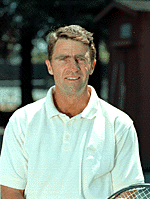 See animation of Hoad
serve. See animation of Hoad
serve.
Way back when Australia dominated the world of tennis with a string of
tennis champions that included John Newcombe, Rod Laver, Roy Emerson, Fred Stolle, Ken
Rosewall, Neale Fraser, and Frank Sedgeman, Lew Hoad stood out from this exceptional group
with unusual talent, awesome power and an easy going style. People still tell the story of
how Hoad once greeted Cliff Mayne of the Berkeley Tennis Club with a "pat" on
the back that nearly sent Mayne crashing. In another story, Hoad was in the finals at the
same club. At match time, Hoad was no where to be found. After a long search he was
discovered snoozing in an easy chair in the members' lounge. Tennis was just a game and
nothing to get all worked up about. Yet in spite of that nonchalance he nearly captured
the grand slam in 1956, winning the Australian, French and Wimbledon crowns, only to be
denied by his countryman and doubles partner Ken Rosewall for the United States title
(there was no US Open back then).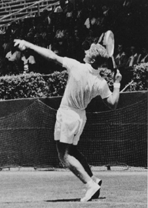 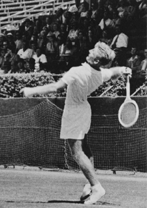
Hoad's service action was compact, fluid, and very powerful. The animated sequence
nicely highlights a number of key pointers on the serve that are often misunderstood
.
So what's interesting here? First examine the drop. There is no scratching
of the back, but rather the racquet swings through the drop, and swings well away from the
body. To practice this on court you want to feel a dynamic (moving) drop rather than
a static drop that stops and then restarts. To continue that idea, as a teacher I
now believe that is better to try and learn the serve as a motion, rather than as a series
of parts that are reassembled after the motion is learned (whenever that might be).
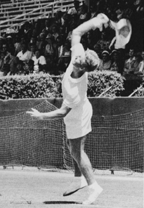 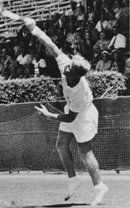
Secondly, look closely at the racquet in the photos to the left. He is not snapping
up and over the ball, but rather snapping the racquet across the ball. Sampras and
Graf serve this way whereas Navratilova and Agassi do not. Servers who whip the
racquet across the ball are able to (among many other serves) serve wide to their off
court, that is, wide to the ad court if you are right handed, or wide to the deuce
court if you are left handed. (As an aside, Graf was able to get over Navratilova on grass
from this one main difference. Since Martina really couldn't serve wide in the deuce
court, Steffi would cheat to the center to return with her big forehand, and Martina
wasn't able to keep Steffi honest with the big serve out wide to the corner. But, Steffi
often served out wide in the ad court, so Martina was denied that same opportunity. And
it's a big handicap when a server can punish you with a wide serve to your forehand.
Speaking of big serves out wide in the deuce court, remember how McEnroe used his
can-opener serve out wide to win big points?
But why snap across rather than up and over? The answer has to do with
leverage and with the size and shape of the serving window. See Part 2 next issue of
TennisONE.
See
animation of Hoad serve.
Send email to the author
We encourage you to email your comments (pro, con, appreciative, whatever) directly to
the author. To send email to Jim McLennan, click
here.
To see other lessons, go to:
Top of Lessons Library |